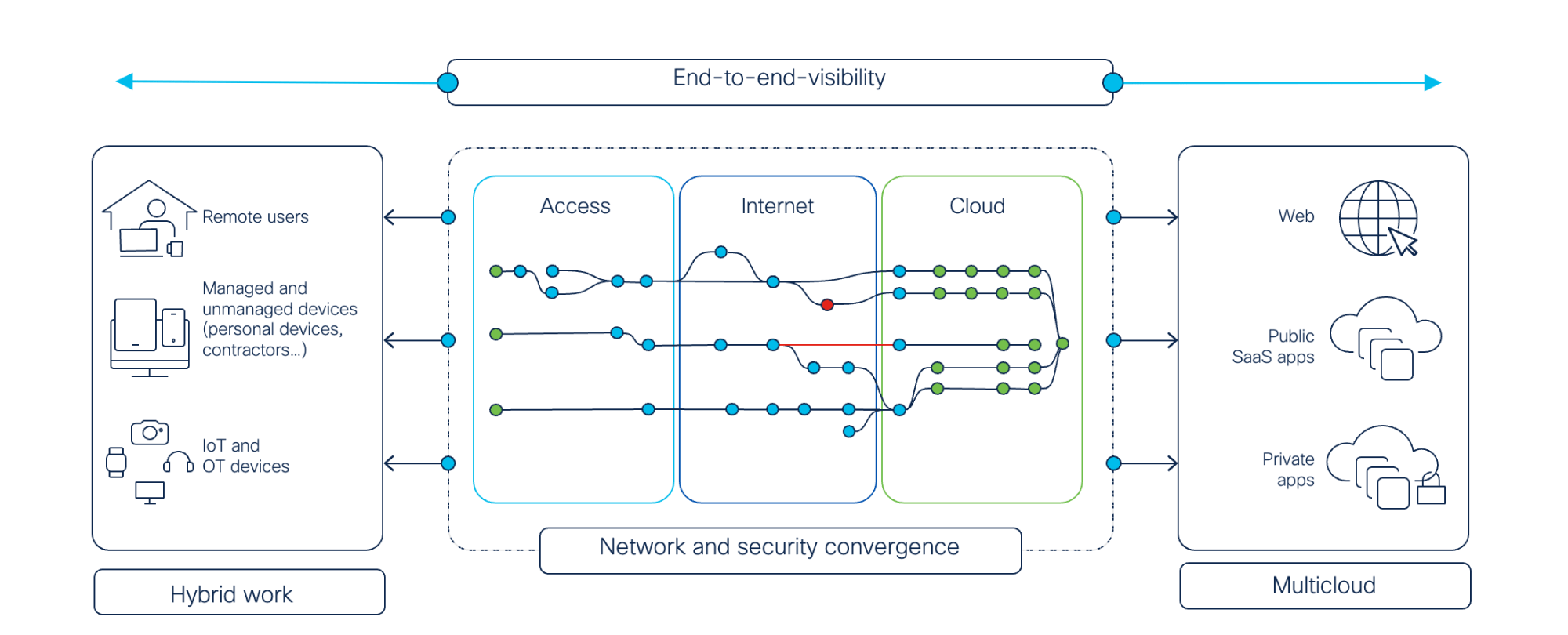
End-to-End Visibility and Actionable Insights Underpin Great Connected Experiences
Part 3 of the six-part series – The 2023 Global Networking Trends Report series
Three networking megatrends have upended how businesses approach networking to support the distributed workforce.
First, cloud has become the new data center, with workloads moving from on-premises to hybrid cloud and multicloud architectures. Secondly, the internet is now the new network, with reliance on business connectivity traversing diverse networking domains. And lastly, with so many remote and hybrid workers, the office is now essentially anywhere.
This evolution has made delivering a high-quality, reliable experience—connecting everyone to everything everywhere—significantly more complex. After the need to provide secure access to applications across multiple clouds, the second biggest challenge cited by 37% of respondents in our 2023 Global Networking Trends Report was gaining end-to-end visibility into network performance and security as more traffic originates or terminates beyond the boundaries of the corporate network.
Which begs the question: How do you identify, diagnose, and remediate problems that occur throughout the digital supply chain—the domains within and outside your infrastructure and all hops between a user’s device and an application or service in the cloud? Read on to find out how.
Tackling assurance complexity across multiple network domains
Great connected experiences are table stakes for businesses today. The digital economy relies on always-on applications and services to support employees and consumers. Failure is not an option.
Prior to the hyperconnectivity of today’s digital economy, business applications and services within corporate domains were well served by network monitoring solutions and processes that were localized and handled specific domains, like wireless. But to remediate issues in enterprise WANs, admins had to contact their counterparts within cloud and internet provider organizations to jointly diagnose and remediate service and security problems. Often, this resulted in a lot of finger pointing. Businesses acted reactively instead of proactively. Issues could take a long time to get resolved.

Figure 1. Complex digital supply chain with interdependencies, increased failure surface, and unpredictability.
Providing network assurance for a high-quality connected experience today requires end-to-end visibility and insights across diverse clouds, network providers, the internet, devices, and geographies—each with their own operational domains (see Figure 1). Without end-to-end visibility into network performance, application responsiveness, and security, it is extremely challenging for IT teams to deliver consistent digital experiences to end users.
A person working from home, for example, might run into a problem with Slack. The wireless network in their home office would be connected to an access network that would be connected to an edge router traversing a cloud network to the Slack application. Domain-specific tools can only see a small segment of this traffic. Admins without end-to-end visibility can’t see the big picture.
End-to-end visibility is foundational for SASE
A majority (51%) of organizations in our 2023 Global Networking Trends Report said that with their adoption of more software-as-a-service (SaaS) and multicloud solutions, they see investment in a solution that provides end-to-end visibility as a top priority. This may be in response to recent research by the Uptime Institute that found third-party operators—including cloud, hosting, colocation, and telecom providers—accounted for 70% of all publicly reported outages.
End-to-end visibility, analytics, and operational workflows allow admins to take decisive action to proactively remediate connectivity issues. In a secure access service edge (SASE) architecture, for example, end-to-end visibility feeds the actionable intelligence used to optimize path selection to provide the best digital experience anywhere at any time. Reliable connectivity is foundational to securely connecting people and things in a SASE architecture. If connectivity is poor, the secure access experience will be degraded.
Even before an SD-WAN or a converged SASE architecture with security service edge (SSE) is rolled out, organizations can use end-to-end visibility to evaluate, compare, and optimize the network experience before and after adoption of these architectures. The performance of individual providers in different locations that each form part of a digital supply chain can be proactively tested and benchmarked, with the results used to make more informed vendor selections to ensure the delivery of always-on digital experiences.
Gaining visibility into every connection
A European airline transitioned its network infrastructure from MPLS to SD-WAN, moving many applications and services to the cloud. The company needed to make sure that services met agreed-upon service level agreements (SLAs). To do so, the IT department deployed end-to-end visibility, specifically to monitor and enhance the digital experiences of customers and employees. With this solution in place, the airline can now measure connection latency and other factors—with a specific focus on connections between its data center and the cloud provider, Amazon Web Services. They can continually monitor and prioritize network experiences by accelerating incident response times, introduce more proactive maintenance, and enjoy greater cost efficiency through streamlined troubleshooting.
RichRelevance, a customer experience personalization provider for 250 global retailers, reduced its outages by 88% and shrunk outage windows from an average of four hours to 30 minutes, all thanks to end-to-end visibility. IT service management software company ServiceNow identified network issues 95% faster for their customers with visibility across all network layers that focused on the application experience.
Enabling quality digital experiences through a networking platform approach
Cisco is pioneering end-to-end network visibility and driving exceptional experiences through operational simplicity. It’s a cornerstone of our Cisco Networking Cloud long-term vision, a unified management experience platform for on-premises and cloud operating models to reduce IT complexity.
End-to-end visibility relies on compute power to capture and analyze billions of daily measurements in the digital supply chains that comprise today’s enterprise networks (see Figure 2). It is a powerful and indispensable feature that helps organizations maintain top-quality digital experiences and move from reactive to preventative and automated operations.

Figure 2. Organizations need to leverage a platform-driven approach that drives end-to-end visibility throughout the digital supply chain (click to enlarge)
Watch the Global Networking Trends on-demand webinar:
“Securely connect people, places, and things in an ever-changing world”
Download the 2023 Global Networking Trends Report
Tags:



